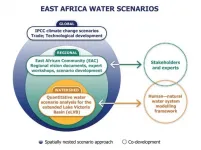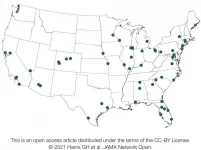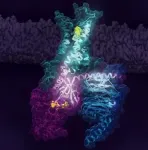(Press-News.org) In light of recent extreme climate events--from wildfires blazing through the western US to snowstorms sweeping Texas into a blackout--climate scientists and media outlets have repeatedly called out the urgency of tackling the climate crisis. But in a new study published March 19 in the journal One Earth, researchers found that emphasizing urgency alone is not enough to kindle public support for climate change policies.
"We had the impression that policymakers shy away from enacting ambitious, stringent climate policy because they're afraid of public backlash. However, if climate change communicators emphasize the urgency of addressing climate change, citizens may become supportive of quick and bold policies," says co-author Adrian Rinscheid of the University of St. Gallen, Switzerland. "Then we thought, 'Why don't we do a study looking at the potential effect that the perceived urgency of climate change has on people's policy support?'
To find answers, the researchers surveyed 9,911 people in Germany and the United States. The team found that people who perceive climate change to be urgent also tend to support general mitigation plans, such as long-term temperature and mitigation targets. But when it comes to personal sacrifices, such as cutting meat consumption and reducing the use of fossil-fuel-powered cars, the sense of urgency doesn't convince people to support these "high-cost" plans.
However, the researchers did find some strategies that might help policymakers advocate for ambitious climate mitigation policies. They found that giving context and information about the purpose and importance of certain policy measures can increase people's support, even for mitigation approaches imposed on consumers that require behavioral change or are costly to individuals. The researchers noted that politicians can also communicate and link the urgency of climate change to corresponding effective near-term solutions to create "quick wins."
"If the governments are open, transparent, engaging, and authentic with climate policies, people actually are more likely to follow, and the risk of public backlash is way smaller," says co-author Lukas Fesenfeld of the Swiss Federal Institute of Technology in Zurich, Switzerland. "Citizens are not the main hindrance."
The researchers also found that while 80% of Germans and 64% of Americans who participated in the survey agree that climate change is already a serious problem today and for future generations, these respondents are significantly less concerned about the consequences of climate change for themselves.
"Extracted information about urgency on its own is probably unlikely to change behaviors and support," says Fesenfeld. "But living in Texas and experiencing snowy days or sitting in a cold flat because your insulation is not made for snow--these real-world experiences and emotional reactions coupled with analytical information might help." One of the team's next steps is comparing and investigating how individuals who experienced extreme climate events react to personalized messages about the urgency of climate change and how they respond to near-term solutions.
"Policymakers can and should really act more ambitiously and quickly in order to prevent the public from feeling climate change too strongly in their own lives in the near future," says Rinscheid. "Some are already experiencing the impacts."
INFORMATION:
This work was supported by EU ERC, the Heinrich Boell Foundation, the Andlinger Center for Energy and the Environment at Princeton University, and the Swiss Competence Center for Research in Energy, Society and Transition SCCER CREST.
One Earth, Fesenfeld and Rinscheid: "Emphasizing urgency of climate change is insufficient to increase policy support" https://www.cell.com/one-earth/fulltext/S2590-3322(21)00116-0
One Earth (@OneEarth_CP), published by Cell Press, is a monthly journal that features papers from the fields of natural, social, and applied sciences. One Earth is the home for high-quality research that seeks to understand and address today's environmental grand challenges, publishing across the spectrum of environmental change and sustainability science. A sister journal to Cell, Chem, and Joule, One Earth aspires to break down barriers between disciplines and stimulate the cross-pollination of ideas with a platform that unites communities, fosters dialogue, and encourages transformative research. Visit http://www.cell.com/one-earth. To receive Cell Press media alerts, contact press@cell.com.
IIASA researchers worked with local stakeholders from the East African Community to explore and co-develop regional water scenarios that can enhance understanding of the up- and downstream water sector interactions in the extended Lake Victoria Basin to facilitate rational water resource planning.
East Africa is the world's fastest growing region outside of Asia, with an estimated growth of 5% and above over the last decade. Part of this success can likely be attributed to the East Africa Vision 2050, which was launched in 2015 by the Heads of States of the East African Community (EAC) - an intergovernmental organization composed of six countries in the African Great Lakes ...
PITTSBURGH, March 19, 2021 - A University of Pittsburgh School of Medicine-led survey of dozens of surge capacity managers at hospitals nationwide captures the U.S. health care system's pandemic preparedness status in the months before the first COVID-19 cases were identified in China.
Published today in the journal JAMA Network Open, the investigation details the strain experienced by U.S. hospitals during the 2017-18 influenza season, which was marked by severe illness and the highest infectious disease-related hospitalization rates in at least a decade. At the time, pandemic planning ...
A new research study at the University of Chicago Medicine has found that when it comes to COVID-19, having vitamin D levels above those traditionally considered sufficient may lower the risk of infection, especially for Black people.
The study, published March 19 in JAMA Open Network, retrospectively examined the relationship between vitamin D levels and likelihood of testing positive for COVID-19. While levels of 30 ng/ml or more are usually considered "sufficient," the authors found that Black individuals who had levels of 30 to 40 ng/ml had a 2.64 times higher risk of testing ...
What The Study Did: This analysis examined how patients with multiple sclerosis who have COVID-19 fare and what patient and disease characteristics are associated with worse outcomes.
Authors: Amber Salter, Ph.D., of Washington University in St Louis, is the corresponding author.
To access the embargoed study: Visit our For The Media website at this link https://media.jamanetwork.com/
(doi:10.1001/jamaneurol.2021.0688)
Editor's Note: The article includes conflict of interest and funding/support disclosures. Please see the article for additional information, including other authors, author contributions and affiliations, conflict of interest and financial disclosures, ...
What The Study Did: Researchers examined if differences in vitamin D levels greater than levels traditionally considered sufficient (30 ng/mL) are associated with having test results positive for COVID-19 in White and in Black individuals.
Authors: David O. Meltzer, M.D., Ph.D., of the University of Chicago, is the corresponding author.
To access the embargoed study: Visit our For The Media website at this link https://media.jamanetwork.com/
(doi:10.1001/jamanetworkopen.2021.4117)
Editor's Note: The article includes funding/support disclosures. Please see the article ...
A multinational research team led by Dr. Adnan Sljoka (RIKEN), Prof. R. Scott Prosser (Univ. of Toronto) with collaborations with Dr. Duy Phuoc Tran and Prof. Akio Kitao (Tokyo Tech) and Prof. Roger K. Sunahara (Univ. of California San Diego) has carried out experimental and computational studies, revealing key steps associated with the activation of the human adenosine A2A receptor (A2AR). A2AR is a member of superfamily of receptors called G protein-coupled receptors (GPCRs) (major drug targets) which engage the G protein and initiates cell signaling. The research team discovered that A2AR is represented by at least two inactive conformations and three active conformations whose populations are dependent on ligands and activation ...
A team of researchers has found disrupting the interaction between cancer cells and certain immune cells is more effective at killing cancer cells than current immunotherapy treatments.
The findings, which include studies in cell lines and animal models, appeared in JCI Insight and focus on END ...
MOSCOW, RUSSIA -
Moscow Center for Diagnostics & Telemedicine and RADLogics shared the results of a large-scale study (Moscow Experiment on the Computer Vision for the Analysis of Medical Images - mosmed.ai, NCT04489992) conducted by the Research and Practical Clinical Center for Diagnostics and Telemedicine Technologies of the Moscow Health Care Department. The clinical research found that the introduction of RADLogics' AI-Powered solution into radiology workflow to analyze Chest-CT scans during the COVID-19 pandemic reduced report turnaround ...
TROY, N.Y. -- A novel form of polymerized estrogen developed at Rensselaer Polytechnic Institute can provide neuroprotection when implanted at the site of a spinal cord injury -- preventing further damage. This promising result, found in a preclinical model, was recently published in ACS Chemical Neuroscience, and it lays the groundwork for further advancement of this new biomaterial.
"What we saw that gives us hope is more neuroprotection, meaning we saw more spared neurons and more spared axons in the tissue," said Ryan Gilbert, a professor of biomedical engineering at Rensselaer, and co-author on this paper. "We believe that the estrogen released from our biomaterial design is providing a neuroprotective response."
After a spinal cord injury, the body's inflammatory ...
The results showed that several psychological well-being measures gradually increased within participants from the beginning to the end of the course. That was especially true for life satisfaction, perceived well-being, self-awareness and emotional self-regulation. The participants in the study also reported a significant decrease in anxiety, perceived stress, negative thoughts, rumination and anger tendencies. The researchers observed, simultaneously, improvements in the positive aspects and a reduction of negative emotions, both in the short term and longitudinally ...



